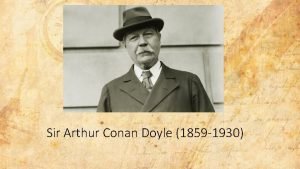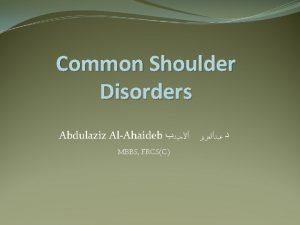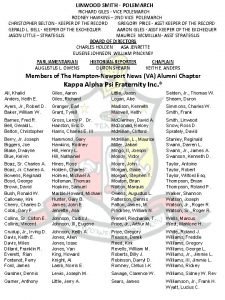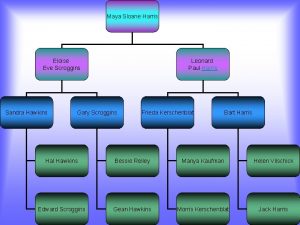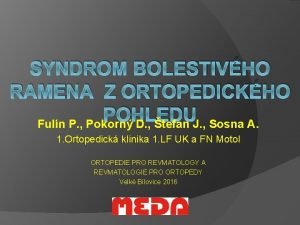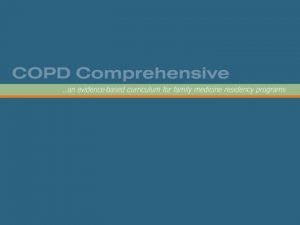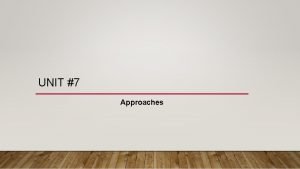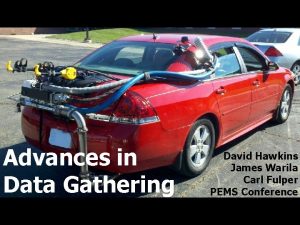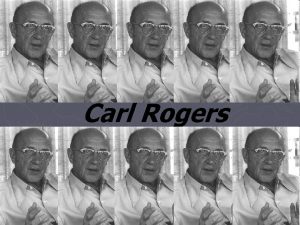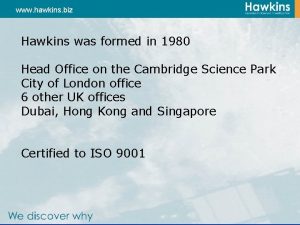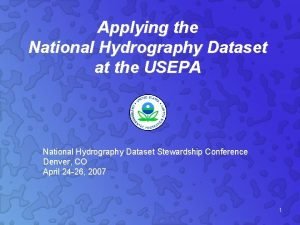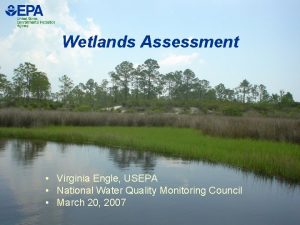James Warila Carl Fulper David Hawkins USEPA National































- Slides: 31

James Warila, Carl Fulper, David Hawkins USEPA National Vehicle & Fuel Emissions Laboratory Ann Arbor, Michigan 2014 PEMS International Conference April 3 -4, 2014 Riverside, California

� “Quality” means � Accuracy AND � Representativeness � Measurement is Difficult and Expensive � Vehicles and Engines are diverse � Vehicles difficult to acquire or recruit � Techniques detailed and expensive � Emissions are highly variable � Vehicles becoming very clean � Small fractions of “dirty” vehicles contribute much emissions � But they are harder to find � PEMS, PAMS have much to contribute! 2

� Experiments �suited to some questions Effect of temperature on emissions Effect of fuels on emissions � Fleet Surveys �Needed to characterize fleets �Needed to characterize “real world” �Needed to get representative averages 3

� For Experiments � Stick with laboratory? Better repeatability? Better experimental control? � Can try PEMS? Less expensive? Less experimental control? � For Fleet Surveys � Can use laboratory instruments � PEMS, PAMS ideal Quicker Less expensive? Can take instruments to vehicle Incorporate real behavior Integrate external conditions 4

Survey and Experiment Estimating Temperature Trends (PM) Experiment Fleet Survey Experiment 5

� Accuracy �Instrument calibration, etc. �Congruence of scale? Scale of phenomenon vs. scale of measurement? � Representativeness �Is the vehicle sample representative? Critical for fleet surveys? Less important for experiments the behavior representative? Laboratory: is the test cycle representative? � Difficult to get both simultaneously 6

� Calibrations �Spans, audits, etc. �Linearity of response, etc. �Drift � Alignment of time series 7

� Scale of Phenomenon vs. Acquisition rate? �We measure emissions @ ~1. 0 Hz �Do emissions occur at 1. 0 Hz? Effects of lag, history, etc. Dilution, mixing in sample train Alignment of exhaust flow, analyzers, etc. � Scale of Phenomenon vs. Measurement Period �How long to characterize the operation of a dozer? 8

Exhaust Flow (kg/hr) Are the time series aligned? If YES, emissions response lags exhaust flow? [NO] (ppm) If NO, we need to realign? How? 9

A Month in the Life of a Dozer Hours of operation by week and day 9/16 -10/25, 2007 Are these typical weeks? Is this a typical month? <insert pic> Can we project: seasonal operation? annual operation? 10

� Is the target population defined? �May be effortless �May be quite difficult �Depends on objectives � How to sample the population? �Sample and average across differences? �Stratify and sample independently? 11

12

Simply seeking dozers? Easy Seeking dozers in size range? Need rated power Seeking dozers certified to Tier-2 Standard? Need rated power and MY 13

All Priuses look alike, but are they the same? Since 2004, Priuses certified to Bin-3 standard, OR SULEV standard How distinguish? Model year not enough Need Engine Family 14

� Convenience �Acquire Sample the vehicles that are handy � Judgment Sample �Develop selection criteria �Acquire “typical” examples � Probability �Select Samples vehicles at known probabilities Equal Unequal �Important for fleet surveys 15

n = 20 n = 10 N = 200 f = 7/10 f = 3/10 16

Like high emissions … n = 20 N = 200 f = 7/10 f = 3/10 n = 10 frare = 2/100 17

It may be worth the trouble to screen first Screen for technology, standards, etc. Screen for emissions level 18

19

Hot-Soak Emissions (g/15 -min) Measured Sample Vehicles: Cars and Trucks MY: 1991 -1995 Index: Remote sensing “Truth”: Hot-soak Evaporative Index (EI 23) 20

Hot-Soak Emissions (g/15 -min) Sc. Sc Projected Fleet Vehicles: Cars and Trucks MY: 1991 -1995 Index: Remote sensing “Truth”: Hot-soak Evaporative Index 21

Hot-Soak Emissions (g/15 -min) Unweighted: MY 1996 -2003 Measured Sample Vehicles: Cars and Trucks MY: 1996 -2003 Index: Remote sensing “Truth”: Hot-soak Evaporative Index (EI 23) 22

Hot-Soak Emissions (g/15 -min) Weighted: MY 1996 -2003 Projected Fleet Vehicles: Cars and Trucks MY: 1996 -2003 Index: Remote sensing “Truth”: Hot-soak Evaporative Index (EI 23) 23

� Heavy Duty Trucks and Buses �Can the chassis dyno simulate high-speed driving while loaded? � Heavy Nonroad Equipment �Can the engine dyno simulate different equipment types � Cars and Trucks �Can the dynamometer simulate road grade? � Advanced technologies �Can a test cycle capture a hybrid’s start/stop pattern? 24

� Heavy Equipment? �Emissions How long does it take to characterize a “duty cycle”? Dozer vs. excavator vs. articulated hauler? � Cars? �Emissions? How long to profile canister purge patterns? How long to profile a hybrid’s start/stop pattern? �Activity? How long to characterize vehicles’ driving patterns? � Starts, soaks, operation? � Including business trips, vacations, etc. 25

� Basis for MOVES emission rates �Exhaust emissions �Running operation � Goals �Relate emissions to power PEMS over short time period (hours – days) �Characterize operating profiles PAMS over longer time period (hours – months) � Method 1: Road-Load method � Method 2: Direct torque measurement 26

�Fields speed (vt, mph, m/sec) (by GPS) �Road-load coefficients (A, B, C) �Vehicle weight (m, Mg) �Calculations �Acceleration by difference (at = vt − vt-1) �VSP by equation �Braking by deceleration 27

� Fields �Vehicle �Engine v speed ( t, mph, m/sec) n speed ( t, RPM) �Torque τ ( , Nm) �Vehicle m weight ( , Mg) �Brake light indicator � Calculations �VSP by equation �Braking by indicator 28

Driving a Prius (with PAMS) down the hill 29

Altitude (ft) Vehicle Speed (mph) Decel/braking mode VSP (k. W/Mg, method 1) VSP (k. W/Mg, method 2) Brake-light indicator 30

� Define your objectives � Define your population(s) under study � Sample the population �Convenience sample? �Judgment sample? �Probability sample? � Measure accurately � Measure representative behavior �Right instrument over �Right period � Result: High Quality data! 31
 Mapa de los niveles de conciencia
Mapa de los niveles de conciencia Hawkins test
Hawkins test Tari sederhana adalah
Tari sederhana adalah Louisa hawkins
Louisa hawkins Jamison hawkins
Jamison hawkins Pecturalis
Pecturalis Maniobra de pinzamiento
Maniobra de pinzamiento Penny hawkins rspca
Penny hawkins rspca Neer and hawkins test
Neer and hawkins test Hugo hawkins
Hugo hawkins Duron shearn
Duron shearn Jean leckie
Jean leckie Karaindros development
Karaindros development Manoeuvre de cozen
Manoeuvre de cozen Sandra hawkins
Sandra hawkins Omuz testleri
Omuz testleri Diane hawkins
Diane hawkins Akromioplastika ramena
Akromioplastika ramena Dr clare hawkins
Dr clare hawkins Asmita karandikar
Asmita karandikar Scsi unit fbi
Scsi unit fbi James russell odom and james clayton lawson
James russell odom and james clayton lawson David james grandad
David james grandad National unification and the national state
National unification and the national state Carl friedrich gauss formula
Carl friedrich gauss formula Carl rogers humanistic theory
Carl rogers humanistic theory Carl gustav jung typologie
Carl gustav jung typologie Theories of personality carl jung
Theories of personality carl jung Trickster archetype
Trickster archetype Carl rogers phenomenological theory of personality
Carl rogers phenomenological theory of personality Kesimpulan teori carl gustav jung
Kesimpulan teori carl gustav jung Sejarah humas
Sejarah humas



